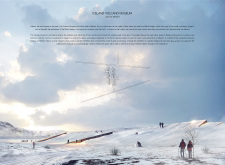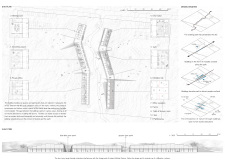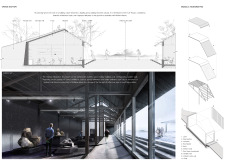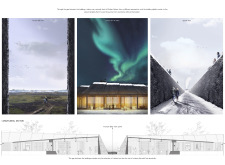5 key facts about this project
The design of the museum prioritizes cohesion with the landscape, utilizing a range of materials such as volcanic rock, concrete, wood, and glass. The use of volcanic rock as a primary material not only reinforces the connection to Iceland's geological features but also enhances the aesthetic continuity of the museum with its surroundings. Concrete provides resilience against the harsh Icelandic weather, while wooden elements draw from traditional Icelandic architectural styles, particularly turf houses. Large glass panels facilitate natural light flow and allow for visual connections to the outside, promoting a sense of openness throughout the interior spaces.
Unique Design Approaches
One of the distinguishing aspects of the Iceland Volcano Museum is its emphasis on engaging visitors with the landscape. The design incorporates strategic pathways and viewpoints that enhance the visitor experience by providing various perspectives of the natural features surrounding the site. The building's layout encourages movement and exploration, guiding visitors through distinct spaces that reflect different geological aspects of the region.
The roof design is another innovative approach within the architecture, gently sloping to mimic the contours of the surrounding terrain. This not only reduces visual impact but also encourages vegetation to thrive on the roof, creating a living landscape that contributes to biodiversity. These sustainable design strategies enhance the museum’s role as an environmentally-conscious facility that respects and integrates with its surroundings.
Architectural Details and Functionality
The interior layout of the museum includes multipurpose areas such as galleries, educational workshops, and communal spaces designed for interaction and learning. The modular arrangement allows for flexible use of spaces, accommodating varying exhibition needs and visitor capacities. Additionally, the incorporation of natural materials throughout the interior contributes to an inviting yet educational atmosphere that promotes a connection to the Icelandic environment.
The architectural sections of the building reveal the attention to detail in structural components, with thoughtful bracketing systems ensuring stability while maintaining a lightweight appearance. This approach not only enhances the building's functionality but also reinforces the design’s overall philosophy of minimal disruption to the landscape.
Explore the project presentation to gain a further understanding of architectural plans, sections, designs, and the unique ideas that define the Iceland Volcano Museum. The comprehensive insights provided will facilitate a deeper appreciation of the architectural nuances and functional aspects integral to this project.


























